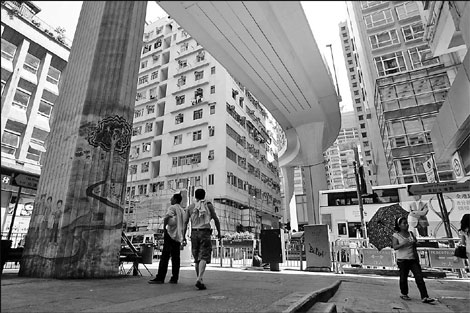Neighborhood with history
|
Shek Tong Tsui is a proud neighborhood full of independent migrants and a colorful past of brothels and opium dens. Edmond Tang / China Daily |
Rebecca Lo gets to know her new neighbors better and finds out more about Shek Tong Tsui's colorful past on the streets showcasing old and new.
It is a neighborhood with history, an old red-light district full of opium dens and elegant brothels, and a district which had inspired Stanley Kwan's 1988 classic love story Rouge, starring two of Hong Kong's most famous thespians, Anita Mui and Leslie Cheung.
But Shek Tong Tsui is also unique in its inherent character.
It is difficult to explain why multiple generations of Chinese families choose to live under one roof. In Hong Kong, they are usually cramped into one tiny flat. The concept of privacy is very different from that in Western households. Though children may share small spaces with their parents, it also means that there is always someone home to open the door if you forget your keys. And there is always something good to eat after a long day at work, handmade with love by a granny who has been using the recipe for decades.
A week after I moved into my apartment in Shek Tong Tsui's Whitty Street, I heard my doorbell ring just as I was about to sit down for dinner. It was elderly Mrs Fung from across the hall, with a steaming plate of handmade pan-fried dumplings.
"We have been making these all afternoon," she says. "Please enjoy!" She returned a few minutes later with some more dumplings in a broth. I asked her to wait while I packaged a few slices of the peanut butter banana cake that I baked, to reciprocate her generosity.
Shek Tong Tsui is known for being a friendly neighborhood with no-nonsense people.
Situated between Kennedy Town and Sai Ying Pun, it is part of the Central and Western District of Hong Kong island. It is a densely developed area that starts at sea level and rises to Pokfulam Road on Victoria Peak. The area gets its name from a stone quarry that was situated between Hill Road and The Belchers, a modern residential development that hugs the hillside.
Hakka folks used this quarry as early as the 17th century, but it wasn't settled permanently until the late 19th century. Its name, "stone pond spit", also refers to it being a headland at one point, although successive waves of reclamation has softened the shoreline.
In the early 20th century, when a plague hit Tai Ping Shan as a result of the poor hygiene in the area, the brothels in Sheung Wan were moved to Hill Road. Many consider this era Shek Tong Tsui's glory days, as the neighborhood flourished until World War II.
The city's rich and famous made it their playground then. Cantonese opera houses and gourmet restaurants did brisk business alongside the opium dens and brothels. The women who worked here were more geisha than Suzie Wong; along with being some of the most beautiful women in the city, they could sing, dance, converse and entertain brilliantly. Their notoriety became the inspiration for soap novels and films such as the Anita Mui and Leslie Cheung melodrama.
After the war and the ban on prostitution, the area was cleaned up and underwent an intense period of development. Most of the buildings erected in the 1950s and '60s still make up Shek Tong Tsui's urban fabric, and the area became a solid, respectable residential area.
Mary Chan, an independent book publisher, grew up in Western District.
"There were still regular Cantonese opera performances," she recalls. "Those were a big deal for the district. My grandmother loved Cantonese opera and we would all hike up the hill with our little stools to secure a good seat."
Freelance public relations consultant Florence Suen remembers going to Shek Tong Tsui as a child to visit family for dim sum. She notes that many people who live in the area are originally from Fujian province or Chaozhou of Guangdong province, doing odd jobs or working as coolies along the waterfront.
"Today, Shek Tong Tsui is not as local," she says. "But compared to other parts of Hong Kong, the people here are very down to earth. They may dress very casually, but they may be billionaires."
"There are a lot of elderly people who enjoy the proximity to the wet market," says part time real estate agent Susan Tsoi. Along with a bustling market, the Leisure and Cultural Services Department-operated building on Queen's Road West houses a library, ball courts and a set of the slowest escalators in the city.
Numerous sitting-out areas encourage seniors to socialize while deliberating over a game of chess, and the tram is a convenient way for them to get around.
"In the 1950s and '60s, there were many new immigrants who settled in Sham Shui Po, Shek Kip Mei, Ngau Tau Kok and Kwun Tong," says Chan. "They were happy to find anywhere to live. If they couldn't get into public housing, then they lived on rooftops.
"But Shek Tong Tsui never had any public housing; it is all privately owned properties. People who live here may have had a great life in China (mainland) but had arrived in Hong Kong with nothing. That's a different type of spirit - they are much more independent."
You can contact the writer at sundayed@chinadaily.com.cn.
(China Daily 07/31/2011 page15)



















